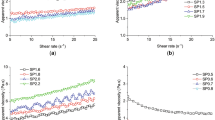Abstract
Shear stress and shear rate data obtained for gypsum plaster pastes were correlated by means of different rheological models. The pastes were prepared from a commercial calcium sulfate hemihydrate at various water/plaster ratios ranging from 100/150 to 100/190. The tests were performed at 25°C using a rotating coaxial cylinder viscosimeter. The measurements were accomplished by applying a step-wise decreasing shear rate sequence. Discrimination among the models was made: (1) on the basis of the fitting goodness; (2) by checking the physical meaning of the calculated parameters; (3) on the basis of the stability of the parameters and of their prediction capacity beyond the limits of the experimental data. In the light of above, the Casson model seemed to be most effective for application to gypsum plaster pastes.
Similar content being viewed by others
Abbreviations
- K :
-
Consistency
- n :
-
Power-law index
- N :
-
Number of experimental data
- P :
-
Number of parameters
- \(\dot \gamma \) :
-
Shear rate (s−1)
- η 0 :
-
Viscosity (Pa · s)
- η d :
-
Dispersing medium viscosity (Pa · s)
- η p :
-
Plastic viscosity (Pa · s)
- η :
-
Viscosity at zero shear rate (Pa · s)
- η ∞ :
-
Viscosity at infinite shear rate (Pa · s)
- [η]:
-
Intrinsic viscosity
- σ 2 :
-
Variance
- τ :
-
Shear stress (Pa)
- τ 0 :
-
Yield stress (Pa)
- ϕ :
-
Solid volume fraction
- ϕ m :
-
Maximum solid volume fraction
References
Chaufin B, Papo A (1983) Materiaux et Constructions 16: 315
Chaufin B, Lapasin R, Papo A (1985) Ind Eng Chem Process Des Dev 24:49
Cheng DC-H, Evans F (1965) Brit J Appl Phys 16:1036
Alessandrini A, Caufin B, Lapasin R, Papo A (1985) Rheol Acta 24:617
Eyring H (1936) J Chem Phys 4:283
Casson N (1959) in: Mill CC (ed), Rheology of Disperse Systems. p 84–104, Pergamon, London
Williamson RV (1929) Ind Eng Chem 21:108
Vom Berg W (1979) Magazine of Concrete Research 31:211
Herschel WH, Bulkley R (1926) Proc ASTM 26:621
Sisko AW (1958) Ind Eng Chem 50:1036
Robertson RE, Stiff HA (1976) Soc Petr Eng J 16:31
Briant J (1956) Revue Ind Franc Petr 11:247
Powell RE, Eyring H (1944) Nature 154:427
Carreau PJ (1968) Rheological Equations for Molecular Network Theories Ph.D. Thesis, Univ. Wisconsin, Madison
Shangraw R, Grim W, Mattocks AM (1961) Trans Soc Rheol 5:247
Lapasin R, Torriano G (1986) Proc XVIII FATIPEC Congr Vol 4:1–41
Eilers H (1941) Kolloid Z 97:313
Papo A (1986) Ciments, Bétons, Plâtres, Chaux (in the press)
Author information
Authors and Affiliations
Rights and permissions
About this article
Cite this article
Papo, A. Rheological models for gypsum plaster pastes. Rheol Acta 27, 320–325 (1988). https://doi.org/10.1007/BF01329748
Received:
Issue Date:
DOI: https://doi.org/10.1007/BF01329748




